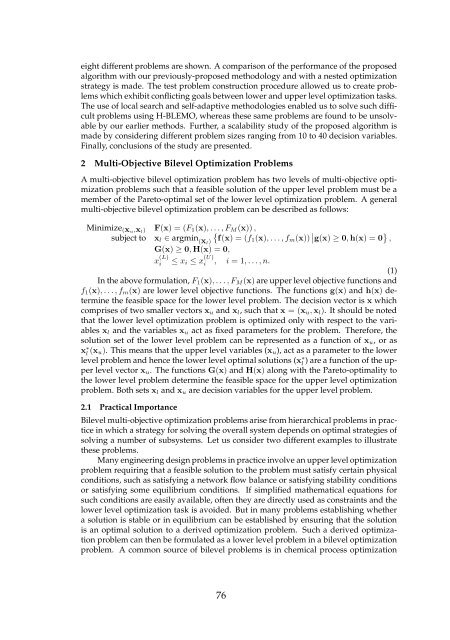Progressively Interactive Evolutionary Multi-Objective Optimization ...
Progressively Interactive Evolutionary Multi-Objective Optimization ...
Progressively Interactive Evolutionary Multi-Objective Optimization ...
Create successful ePaper yourself
Turn your PDF publications into a flip-book with our unique Google optimized e-Paper software.
eight differentproblems areshown. Acomparisonof theperformanceofthe proposed<br />
algorithmwithour previously-proposedmethodology andwithanested optimization<br />
strategy is made. The test problem construction procedure allowed us to create problemswhichexhibitconflictinggoalsbetweenlowerandupperleveloptimizationtasks.<br />
The use of local searchand self-adaptivemethodologies enabledus to solve suchdifficult<br />
problems using H-BLEMO, whereas these same problems arefound to be unsolvable<br />
by our earlier methods. Further, a scalability study of the proposed algorithm is<br />
made by considering different problem sizes ranging from 10 to 40 decision variables.<br />
Finally, conclusions of the study arepresented.<br />
2 <strong>Multi</strong>-<strong>Objective</strong> Bilevel<strong>Optimization</strong> Problems<br />
A multi-objective bilevel optimization problem has two levels of multi-objective optimization<br />
problems such that a feasible solution of the upper level problem must be a<br />
member of the Pareto-optimal set of the lower level optimization problem. A general<br />
multi-objective bilevel optimizationproblemcanbe describedas follows:<br />
Minimize (xu,xl) F(x) = (F1(x), . . . , FM <br />
(x)) ,<br />
subject to xl ∈ argmin (xl) f(x) = (f1(x), . . . , fm(x)) <br />
g(x) ≥ 0, h(x) = 0 ,<br />
G(x) ≥ 0, H(x) = 0,<br />
≤ xi ≤ x (U)<br />
i , i = 1, . . . , n.<br />
x (L)<br />
i<br />
(1)<br />
Intheaboveformulation, F1(x), . . . , FM (x)areupperlevelobjectivefunctionsand<br />
f1(x), . . . , fm(x) are lower level objective functions. The functions g(x) and h(x) determine<br />
the feasible space for the lower level problem. The decision vector is x which<br />
comprises of two smaller vectors xu and xl, such that x = (xu, xl). It should be noted<br />
that the lower level optimization problem is optimized only with respect to the variables<br />
xl and the variables xu act as fixed parameters for the problem. Therefore, the<br />
solution set of the lower level problem can be represented as a function of xu, or as<br />
x ∗ l (xu). This means that the upper level variables (xu), act as a parameter to the lower<br />
levelproblemandhencethelowerleveloptimalsolutions (x ∗ l )areafunctionoftheupper<br />
level vector xu. The functions G(x) and H(x) along with the Pareto-optimality to<br />
the lower level problem determine the feasible space for the upper level optimization<br />
problem. Bothsets xl and xu aredecisionvariablesfor the upperlevelproblem.<br />
2.1 PracticalImportance<br />
Bilevelmulti-objectiveoptimizationproblemsarisefromhierarchicalproblemsinpracticeinwhichastrategyforsolving<br />
theoverallsystemdependsonoptimalstrategiesof<br />
solving a number of subsystems. Let us consider two different examples to illustrate<br />
these problems.<br />
Manyengineeringdesignproblemsinpracticeinvolveanupperleveloptimization<br />
problem requiring that a feasible solution to the problem must satisfy certain physical<br />
conditions, such as satisfying a network flow balance or satisfying stability conditions<br />
or satisfying some equilibrium conditions. If simplified mathematical equations for<br />
such conditions are easily available,often they aredirectly used as constraints and the<br />
lower level optimization task is avoided. But in many problems establishing whether<br />
a solution is stable or in equilibrium can be established by ensuring that the solution<br />
is an optimal solution to a derived optimization problem. Such a derived optimizationproblemcanthenbeformulatedasalowerlevelprobleminabileveloptimization<br />
problem. A common source of bilevel problems is in chemical process optimization<br />
76
















